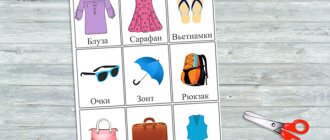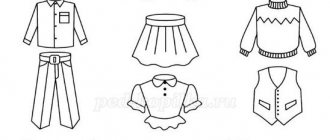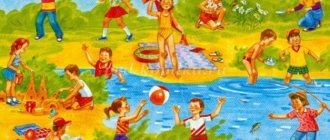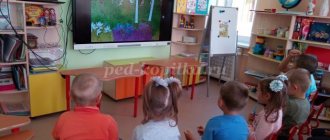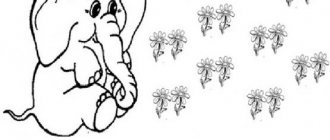Thematic plan of work in the preparatory group for the week “Clothing. Shoes. Hats"
25
A week. " Cloth. Shoes. Hats. Materials".
Target.
To form children’s ideas about the types of clothing according to the seasons, the purpose of hats, items of clothing, and their details. Teach children to name different types of clothes, shoes, hats, what they are made of, knitted. Learn to distinguish and compare leather, wool, silk, cotton, down. Where and how they get it, grow it, produce it.
Learn to identify parts of clothing, shoes, identify by color, material, material, season: winter, summer, spring; what is it intended for? Select actions for items of clothing, shoes: sew, cut, iron, wash, mend, dry, etc. Disassemble the structure of clothing according to the pattern: sleeve, front, back, pocket, collar, cuffs, frill.
Name the professions of people associated with the production and manufacture of clothing and shoes: seamstress, tailor, shoemaker, fashion designer, cutter. What do they do, what tools, machines, electrical appliances do they use.
Word formation of adjectives from nouns: /shoes - shoemaker, seamstress - sewing, etc./
Verbs of the opposite meaning /put on - take off, fasten - unfasten, sew on - rip off, etc./
Fiction: N. Nosov “Patch”, “Living Hat”, N. Konchalovskaya “It’s in the Hat”, M. Rabinovich “From the Life of Ancient Moscow”, “Nikita Kozhemyaka”, K. Ushinsky “How a Shirt Grew in a Field”, M. Zoshchenko “Stupid Story”, N. Oseeva “Magic Wand”, S. Ya. Marshak “Gloves”, Br. Grimm “The Brave Little Tailor”, C. Perrault “Cinderella”
Fairy tales: “Everyone got his own,” “Why doesn’t the month have a dress,” “Who sewed the dress?” (Chrestomathy 1990 p. 54),
January 30. Monday.
Morning.
Work in a corner of nature:
Didactic game “Guess which flower?”
C.
Teach children to guess riddles about plants, focusing on the description of the characteristic features of the flower, give reasons for their answer, and find the answer among indoor plants or in drawings. Strengthen the ability to care for plants.
Conversation with children on the topic
"Cloth". Clarify the names of clothing items, what are the clothes for? What clothes are worn at different times of the year.
Ind/r. D/game “Name the clothes (winter, summer, home.” Activate the speech of Tanya, Vova, consolidate in composing sentences, develop coherent speech,
Learn proverbs with the children and explain what they mean, how they understand these proverbs: “They are greeted by their clothes, they are seen off by their minds.” * “After Senka and the hat.”
The games “Who can name the most items of clothing”, “What are the differences between dolls” expand the volume of vocabulary, develop the ability to substantiate their judgments.
Visual activities.
Ind/r. With Angelina, Diana. Ts. learn to draw clothes for a boy and a girl using a stencil.
Morning exercises
Preparing for breakfast. Breakfast.
GCD. Cognition.
(The world).
Integration of areas:
“Socio-communicative development”, “Cognitive development”, “Speech development”.
Class.
Subject. "Clothing at different times."
(RTV. System operator)
Target. To introduce children to the origins of Russian culture. Introduce children to clothing at different times. Introduce the history of clothing creation. What clothes were worn in the old days, nowadays? Introduce children to the purpose of headgear and gloves? Expand children's horizons. Reinforce acquired knowledge in a playful way. Develop creative initiative in children.
Vocabulary work: frock coat, caftan, cassock, top hat, etc.
Preliminary work:
Excursion to the Russian Izba Museum Purpose. Look at antique clothing items with your children.
- Invitation to the Russian Izba Museum
- Acquaintance with ancient clothing: caftan, frock coat, kokoshnik, shirt, trousers, etc.
- Dolls in different national costumes: Russian, Circassian and Uzbek visiting children.
GCD plan.
- Surprise moment “Kuzya the Little Brownie”
- Organizational moment: “Tell me, what clothes are you wearing?”
- Poems “Clothes” by V. Miryasov
- Scheme: system operator “Clothes”:
I. Present tense:
1) looking at illustrations of clothes of a boy and a girl; 2) clothing factory, atelier, sewing workshop; 3) structure of clothing;
II. Clothes of the past
: 4) From the history of clothing: examination of models of ancient clothing. /What clothes did our ancestors wear/; 5) Seamstresses, tailors, sewing machines, cutters, hand sewing; 6) features of ancient clothing: frills, frills, embroidery, lace.
III .
Future tense:
7) Clothes of the future: we model, we fantasize, we invent.
8. Factory of the future: sewing machines, robots, computers.
9. Children’s drawings on the topic: “I am a fashion designer”
- Physical exercise. "
Once upon a time there lived little gnomes in a house"
- Game (with a ball) “Call it kindly” (collar, sleeve, etc.)
- Game “What are the clothes made of?”
- Proverbs.
- Bottom line. Exhibition of children works
Class. FISO
Target.
To develop organization, dexterity, dexterity, and physical qualities.
Walk
1 Observation of the properties of snow.
Reading “White Snowflake”, K. Balmont. C .
Continue to introduce children to the properties of snow, the structure of snowflakes, teach children to talk about the shape of snowflakes, their properties (light, cold, made up of tiny pieces of ice of different shapes, melting from the warmth of your hands).
2. Didactic game “Who does what.” C. Replenish children’s vocabulary, teach them to name actions in words, and compose riddles, which are based on a list of actions characteristic of the riddled object.
3. Finger gymnastics “Snowball”. C. Develop fine motor skills of children’s hands, teach them to perform movements according to a model, and independently invent movements in accordance with the text of the poem.
4. Outdoor game “Treasure Search”. C. develop coordination of movements, spatial orientation, and improve motor skills. To develop in children the ability to follow the rules of the game.
Games “From hill to hill”, “Obstacles on the way”. C. Develop strength, agility, endurance.
Preparing for lunch. Dinner.
Preparation for sleep.
2nd half of the day.
.Gymnastics after sleep
2. Preparing for afternoon tea. Canteen duty.
Conversation with children on the topic “In the atelier.”
Target. Expand and deepen children's knowledge about the environment. Learn to understand words denoting the names of objects, actions with them and qualitative characteristics.
D/game “What are clothes made of”
Determine the material: cotton, linen, down, wool.
What is a sweater knitted from, a coat, sundress, blouses made from?
— What do they sew from cotton, silk, knitwear? What is made from wool? Which clothes? When to wear woolen clothes?
When do people wear fur/down/ clothes?
—Where do people get clothes? Where do they sew? What are clothes used for?
GCD Artistic creativity.
Paper construction.
Subject. "I am a fashion designer." "Festive round dance." Page
121 Goal.
Learn to compose an image of a person: develop a sense of composition, color, and the ability to cut out a silhouette of a person folded in half along the contour. Trace the silhouette on colored paper, cut it out, creating clothes and decorating them with details. To develop children's ability to find a place in their work when gluing figures on a common sheet, select a color that matches well. Develop creativity, imagination, thinking.
GCD plan.
- Conversation with children about upcoming work.
- Looking at clothing illustrations.
- Examination of blanks. Discuss with children how they can be used in their work.
- Children's stories about the shape of parts of clothing and the human body, their location.
- Show a sample of work.
- Children's work.
- Exhibition of children's works.
Club "Basketball"
Walk 2.
Ice monitoring.
C.
Introduce children to such a seasonal phenomenon as ice, explain the nature of this phenomenon, discuss with children what properties of ice (hard, brittle, smooth, slippery) determine the danger of ice.
2. Didactic game “Who has what clothes?”
C.
Use children's knowledge about clothing, describe the features of winter clothing to solve a game problem, and develop the ability to pronounce sounds correctly.
3. Outdoor game “Don’t stay on the ground.”
Teach children to quickly navigate the area, improve basic types of movements, and develop dexterity.
4. Independent activity of children. Games with various “constructions made of snow on the site.”
C.
Teach children to use structures in their games, play out various plots, and complement buildings with various attributes.
Ind. work: “On the icy path.” Target:
develop coordination of arms and legs when moving, a sense of balance, agility, and the ability to glide on ice.
5. Labor activity. Clearing paths. C.
Improve children's ability to use shovels, teach them to act together, and help each other.
Evening.
1.
1. Introduction to decorative and applied arts.
Conversation “What do you know about the art of Gorodets masters?” C.
Continue to introduce children to Russian folk crafts, teach them to recognize Gorodets products, paintings, and cultivate respect for the work of folk craftsmen.
2. Outdoor game “Entertainers”.
C.
Teach children to come up with a variety of movements, clearly follow the instructions that they cannot repeat the movements shown by others, and accurately repeat the movements of the driver.
3.Free play activities for children in activity centers.
Interaction with parents
Distribute poems and proverbs about clothing for memorization.
January 31st. Tuesday.
1 half day.
Reception of children.
1. Life safety.
"
Dangerous situations." Conversation about safety precautions on the street in winter. Why you can’t eat snow or touch metal objects. How to breathe correctly. Goal: Continue to introduce children to the rules of behavior in winter.
2. Guessing riddles about clothes. Teach children to guess riddles-descriptions, comparing all the named signs, justify their answer, proving that all these qualities, properties or actions are characteristic of the riddled object.
3. Role-playing game “Shop”. Teach children to select various means to display and develop the idea, distribute roles taking into account the capabilities and desires of each participant in the game, set rules and strictly follow them.
4. Introduction to art. Examination of a still life with objects made by human hands (“Still Life with a Samovar” by I. Mashkov).
C.
Teach children to carefully examine the picture, highlight the object that is the center of the composition, and give the picture a name. Tell children about how artists use cold and warm colors to convey mood.
Morning exercises.
Preparation for breakfast, breakfast.
GCD
Lesson.
FEMP. Integration of areas.
“Cognitive development”, “Speech development”, “Social and communicative”.
Subject. "Volume Measurement".
Target.
To form an idea of measuring volumes using a measure, and the dependence of the measurement result on the choice of measure.
To consolidate an understanding of the meaning of addition and subtraction, the relationship between the whole and parts, ideas about difference comparisons of numbers on a subject basis, counting skills within 8.
GCD plan
- Brainstorm: “Where, what is it?” (for orientation in space).
- Volume Measurement: Introduces the technique of measuring volume using a measuring stick.
- Exercise. Prove how the dependence of the measurement result depends on the size of the measure.
- Physical exercise “River” (We quickly went down to the river, bent down and washed ourselves...)
- Exercise. “Measuring the volume of spatial figures with cubes.”
- Game "Cubes" (Cubes in a box: how many cubes do you need to put on the bottom of the box?
- Game “Build a figure from cubes (4, 5, 6)”
- Work in a notebook.
- Bottom line.
MUZO lesson
. (According to the specialist's plan)
Swimming.
Excursion to the ecological room.
Observation of fish - fry. Draw the children's attention to the fact that fry, baby guppies, have appeared in the aquarium by their appearance (size, tail length, fins). Watch them swim and swallow food. Target. Learn to watch fish. Develop a cognitive interest in the animal world.
Theatrical activities.
Basics of acting.
Target. Improve the ability to improvise, develop children's improvisational abilities, resourcefulness, imagination, fantasy.
Sketches
: “Snowflakes are falling and spinning.” “There are two chickens on the street”, “Meeting”, “Yes - no” (benevolent, calm, etc.)
Exercises
: “At the mirror”, “Depict the mood” /facial expressions, gestures/. "What makes winter sad"
Dramatizations:
“The pranks of Emelya, Kikimora, Barmaleya, Baba Yaga”, “Living Hat”
Free play activity
.
Reading N. Nosov’s story “The Living Hat.” Target. Introduce children to stories, form an evaluative attitude towards the characters, comprehend the content of what they read, and coherently convey the content through games.
Preparing for lunch
.
Dinner.
Sonchas.
2nd half of the day.
Reading the story by K. Ushinskog “How a shirt grew in a field”
Integration of areas.
“Cognitive development”, “Speech development”.
Target. Teach children to feel and understand the characters, perceive the originality of the plot, notice the genre features of the composition of the language, teach them to convey their attitude to the plot of the story.
GCD Artistic creativity.
Integration of areas.
“Social-communicative”, “Artistic-aesthetic”, “Speech development”.
Subject. Based on Gorodets painting. "Decoration of the kokoshnik."
Target.
Continue introducing children to Gorodets painting; consolidate the ability to create a decorative design, highlight the characteristic features of Gorodets painting, create a painting based on Gorodets, conveying its characteristic features, mix paint colors; continue to introduce decorative folk art..
GCD plan.
- Conversation with children "Gorodets - a city on the Volga."
- Examining the patterns of Gorodets painting: roses and kupavkas, the colors of the patterns.
- Game “Products of Gorodets Painting Masters”
- Where are Gorodets painting products found?
- Game “Describe the patterns of Gorodets painting”
- Considering several design options.
- Show a sample of work.
- Children's work.
- Bottom line. Exhibition of children's work.
Walk 2.
Observation "Winter landscape". Teach children to see the beauty of the winter landscape, to examine snow patterns on trees and snowdrifts. Develop aesthetic feelings.
2. Outdoor game “Find your house.” To help improve the basic movements of children when running, to teach them to run freely, easily, and navigate in space. Develop creativity in motor activity.
3. Sports exercises. Let's draw a path .
Walking in the snow like a snake one after another.
* Myself. play activity. Games with external material at the request of the children. Cultivate friendly relationships.
4. Role-playing game “Home”.
Using the method of indirectly guiding the game, invite children to play out various situations that have taken place in the children’s lives
Evening. 1. Theatrical activities. Finger Theater “Gloves” after S. Marshak .
Introduce children to Russian folklore, captivate them with the plot, teach them to play along with the teacher. Develop artistic abilities, enhance the emotional and speech development of children.
2. Reading the Ukrainian folk tale “The Mitten.”
Teach children to answer questions about the content of the fairy tale, the characters and actions of the characters, and the events that happened to them.
Visual activity. Coloring pages. Strengthen the ability to draw round shapes and paint over objects. Teach Rodion and Rita to hold a pencil correctly.
S/r game “Beauty Salon”, C. Help children unite in small groups based on personal sympathies, cultivate a friendly attitude towards each other.
Contents of a developmental environment for children’s independent activities
Introducing illustrations on the theme “Fashion and grace”. Examination of illustrations, albums, literature, discussion of the material.
Interaction with families
Conversation with parents: Find out from parents who wants their children to take part in the “Test Yourself” Mathematical Olympiad, make a list of those willing.
— Recommendations for parents on the topic of the week: review spatial relationships with children.
1st of February. Wednesday
1 half day.
Morning.
1.
3.
Work in a corner of nature.
Examining a houseplant (Chlorophytum).
C. Introduce children to a houseplant, offer to examine it, talk about its structure, shape and color of leaves and flowers. Tell the children about the features of this indoor plant (unpretentious, does not require a lot of light or water, blooms in winter).
2.
Breathing exercises .
1. Stroke the wings of the nose from the tip to the bridge of the nose (inhale). As you exhale, tap the wings of your nose 5-6 times with your index finger.
2. Take 8-10 inhalations and exhalations through the right nostril, then through the left, taking turns closing the resting one with your index finger
3. Inhale through your nose. As you exhale, draw out the sound [m] protractedly, while simultaneously tapping your fingers on the wings of your nose.
2.
Conversation “Doll in Russian costume.”
What are these clothes called? (examine the details of the costume with the children, introduce them to the names). Explain that every nation has its own national costume. They are sewn and decorated with folk details, consider them, introduce them and fix the names.
2. Training game
“Touch the one who is wearing the clothes I will name.”
C.
Teach children to talk about their own and their friends’ clothes according to plan, describe their external characteristics, and talk about their purpose.
4. Didactic game “Pick by shape.” “Make a mosaic pattern”
C.
Teach children to compare the shape of objects with basic geometric figures, name them correctly, and develop visual perception.
GCD.
Class.
Speech development. Compiling a story based on a picture using a diagram.
Subject. "Cloth". D/i "Atelier".
Target.
Expand and deepen children’s knowledge about the world around them. Learn to understand words denoting the names of objects, actions with them and be able to give a qualitative description. Develop the ability to establish simple connections between objects. Clarify the names and purposes of items of clothing, hats, and their details. Form an idea of the types of clothing according to the time of year. Learn to compare, highlight and describe people’s seasonal clothing.
Met/pr
. organizational moment: examination of illustrations, conversation on the content, answers to questions: what do you see, name it in one word, name winter clothes, at what time of year they wear a raincoat, fur coat, T-shirt. Riddles, writing sentences, artistic expression, reflection.
GCD plan
- Organizational moment: the one who repeats will sit down: - collar, cuffs, sleeves, - zipper, buttons, loop, etc.
- Repeat prefixed verbs from the word sew: - a seamstress sews clothes; a seamstress sews on a button; the seamstress alters the collar, etc.
- children pass the doll to the music. When the music stops, whoever has the doll, that child must answer the questions (What clothes is the doll wearing? What color is the dress on the doll? What is on the doll’s head? What color are the socks?..)
- A game. “Describe your friend’s clothes”, “Recognize the clothes from the scriptures”
- Riddles about clothes.
- Examination of illustrations, paintings.
- Compiling a story according to a scheme (color, material, details, season, type of clothing (children's, men's, women's, home), what do they do with it?).
- Children's stories
- Bottom line.
GCD Artistic creativity.
Drawing.
Subject. Drawing. Subject. "Haze. Young lady »
Goal .
Introduction to decorative and applied arts.
Conversation “What do you know about the art of Dymkovo masters?” C.
Continue to introduce children to Russian folk crafts, teach them to recognize Dymkovo painting on white, observe the ratio of size and proportions, apply patterns evenly, and cultivate respect for the work of folk craftsmen.
Strengthen the ability to work with a brush (hold the brush correctly, dip it into the paint with all its bristles, remove excess paint on the edge of the jar); Strengthen knowledge of flowers; make you want to draw .
Materials and equipment
: pictures depicting Dymkovo toys.
Paints of different
colors are an artistic word.
GCD plan
- Reading “In the Dymkovo Toy Workshop”
- Examination of illustrations and patterns of Dymkovo painting.
- Conversation on the topic
- Show sample work
- Children's works
- Analysis of children's works.
Walk
1.
Swimming.
In Group. Didactic game “Who am I?”
C.
Teach children to write riddles-descriptions, in which the hidden object must be recognized by appearance, clothing, and activate in children’s speech concepts related to the name, details and properties of clothing items.
2. Book repair work.
C.
Invite children to choose books that need repair, guess what happened to these books, and, based on signal drawings, repeat the rules for handling the book. Organize the work of repairing books, teach them to use the words “glue”, “repair”, “craft”, “good deed”, “binding”.
3. Construction games. "We're building a bridge."
C.
Teach children how to make a bridge, a descent for cars, teach how to make a building commensurate with the cars chosen for the game.
Preparing for lunch. Dinner.
2 half day.
Conversation
with children on the topic “Clothing”.
D/game “Magic Chest”.
Purpose: To fix the name of the fabrics. Children, look, we have a magic chest in our group. Let's take a look at it (different types of fabrics) What is it? (consider each type, determine the qualities using visual and tactile sensations, introduce the name).
What is the fabric for?
What can you sew from fur? When can this be worn?
What can you sew from leather?
Did. game “What's extra” C.: exercise in classifying items of clothing into shoes, clothes and hats.
Reading N. Nosov “Patch”.
Target. To teach children to feel and understand the nature of the images of works of art, to assimilate the sequence of plot development, to notice expressive and visual means that help reveal the content; enrich speech with phraseological units; learn to understand the figurative meaning of some phrases and sentences.
Proverbs: “The eyes are afraid, but the hands are doing.” “Measure seven times and cut once.”
Goal To teach children to explain the semantic meaning of proverbs.
Walk 2.
Frost observation. What are the days like, how cold is it, how does it sting your cheeks and nose? Why can't you go for a long walk on frosty days? Teach children to observe the signs of winter and draw conclusions.
2. Work on the site. We clear snow from playgrounds and slides. Highlight areas for jumping with colored paint. To develop Vladik V. and Vanya’s interest in work activities and a responsible attitude towards the results of their work.
3. P/. games “Golden Gate” /running/, “Stop” /attention/, “Horses” /jumping/
4. Game for developing attention and hearing “Who called”
5. Games with v/m, s/r. game “Souvenir Shop”, to develop in children the ability to show initiative, independence in play, and creative abilities.
Evening.
S/r games “Kindergarten”, “Family”. Mothers take their children to the daycare center, and the children are met by a teacher. Conducts charging. The teacher's assistant sets tables, lays out food, washes dishes, etc. Target. Continue to teach children to combine games into one story. Distribute roles by agreement. Bring knowledge from personal experience to the game. During the game, cultivate a culture of communication. /Ksyusha, Nastya, Diana/.
2. Game “What happens...?” (red, green, orange, yellow, etc.). Target. Development of non-voluntary memory, figurative memory, attention, thinking.
3. Offer Nastya Sh., Lera, Vlad V., Vanya, Roma scissors, colored paper. Target. Exercise children in cutting out symmetrical figures from paper folded like an accordion.
Interaction with parents
.
- Consultation for parents “What to read with children at home on the topic “Clothing”.
- Conversation with parents: Find out from parents who wants their children to take part in the “Test Yourself” Mathematical Olympiad, make a list of those willing.
- Recommendations for parents on the topic of the week: review spatial relationships with children.
February 2. Thursday.
Morning reception of children.
Conversation with children on the topic “Purpose of clothing”
How do people choose their clothes? What are clothes and shoes made from? Where do they sew? What should a person do with clothes and shoes so that they always look neat? Remember the words from the fairy tale “Moidodyr”: “And stockings and shoes ran away from the dirt.” Why did they run away? Let's come up with rules on how to care for clothes and shoes? Why do you need to take care of clothes and shoes?
Play activity
. Didactic games: “Types of clothes”, “When, what, they wear” The teacher shows pictures of nature at different times of the year and invites those children who have clothes for winter to hold up cards. What is it called? (winter)
Show cards with clothes for summer. What is it called?
— Ind. work on FEMP.
Tasks: “Count the objects” (up to 8). “Connect the pictures with the required numbers”, “Complete the beads” “Draw as many objects as indicated by the number. (Pictures depicting geometric shapes, cards with numbers, objects). Individual sheets with tasks.
Base game “Autoline”, “Be careful”, “Find a friend”.
GCD. Speech development.
Subject
"Cloth. Shoes. Hats"
Goals:
Fix the names of outerwear, shoes, hats; teach to compare objects, introduce the components of objects. Make up stories based on the picture. Answer questions about who is depicted, what they are doing, where they are? Match words with signs. Development of coherent speech, the ability to write a descriptive story, expansion of vocabulary; activation of tactile sensations and the ability to convey them in words; training of articulatory muscles, its strength and ability to hold and change articulatory positions; fine motor skills, attention and self-control.
GCD plan.
- Looking at the painting.
- Conversation about winter clothing on issues.
- D/games “One is many”, “Name the types of fabric”, “Name the parts of the clothes”, “What is missing in the clothes”, “Compare the shoes”, “What are hats for”, “Say the opposite”.
- Making sentences based on supporting words,
- reading a poem.
- Lexical work, articulatory gymnastics,
- physical min., finger games.
- work with drawing.
- Reflection.
Class.
Modeling. Topic: “Handkerchief for a doll.”
Target.
Learn to sculpt a square object from a piece of plasticine. Strengthen the ability to roll it out with circular movements of your palms and flatten it between your palms to obtain the desired shape. Decorate the edges with a felt-tip pen cap.
Walk.
Watching the snow.
Experience.
Invite the children to catch a snowflake, hold it in their hand, and see what happens to the snow.
Reinforce the properties and qualities of snow with children, and practice selecting definitions for the word “snow.” Mystery.
- He is fluffy, silver,
But don’t touch him with your hand;
It will become a little bit clean,
How can you catch it in the palm of your hand?
2. Labor. Landscaping of the site. Clean up the area and clear away the freshly fallen snow. Cultivate hard work in Sasha and Vika.
3. Outdoor games “Get into the well” /throwing/, “Rabbits” /jumping/.
4. Ind. physical work Exercise Lesha and Vova in long jumps, develop coordination of movements and jumping technique.
5. Sports game "Hockey". Target. Practice rolling the puck with your stick in a given direction.
6. Downhill sledding on ice sleds.
2nd half of the day.
Conversation with children on the topic “Seasonal clothing.” Page 361
Target. Reinforce the general concept of “clothing”, learn to name seasonal clothing and solve riddles; introduce the profession of fashion designer; repeat well-known works of small forms of folklore, introduce new works..
Questions: Who is the rag doctor who treated the coat (tailor).
Riddles: = The jester's cap is removed from the head, put on the feet, there are no bells. Whoever puts it on doesn’t know the cold (tights).
= I will cover any girl’s hair, and I will also cover short hair for any boy. I am protection from the sun – that’s what I was made for. (Panama). Etc.
Games “Arrange the pictures by season”, “One is many”, “Name the extra piece of clothing”, “Correct the mistake”. Target. Find out from children what they understand by the definition of “seasonal clothing”, teach them to classify clothing by season.
Origami. "Shirt".
Goal To strengthen children’s ability to fold a rectangular sheet of paper in different directions, develop their eye, cultivate perseverance and accuracy in work.
Walk . _ 1. Observing people's clothes.
Target. Consider the clothes of children and passers-by, clarify the name and purpose. Observing the actions of passersby. Teach children, based on the results of observations, to talk about the peculiarities of choosing clothes in winter, people’s behavior on a frosty day, to activate in speech concepts associated with winter clothing and its qualities
2.
Landscaping of the site. Put the buildings, the slide, the steps on the slide in order, clear the ice path of snow. Involve inactive children in work /Demyan, Vova G./.
3. Games with snow: tunnels, wells, passages, etc. support children’s initiative in building snow buildings, improve Nikita and Vladik’s design skills.
4. Ind/r. practice rolling the puck with a stick to each other with Vanya and Kirill.
5. Sports. game "Hockey", p
Base games "from hill to hill" /endurance/. “Running along snow paths” /coordination of movements/, “Snow shooting range” /throwing/.
Evening. 1. Theater is an activity. Finger Theater.
Acting out the fairy tale “The Lapotnitsa Fox”, discussion, fixing the names of the characters, acting out the fairy tale.
C.
Introduce children to Russian folklore, captivate them with the plot, teach them to play along with the teacher. Develop artistic abilities, enhance the emotional and speech development of children.
Role-playing game "Kindergarten".
C. Using the method of indirectly guiding the game, invite children to play out various situations that have taken place in the children’s lives
3. Work in the sensory education corner.
C.
Teach children to compare the shape of objects with a model, group objects by shape, and record their impressions in speech.
Offer constructors to construct a building from a constructor, teach how to build different options. Specify the sequence of work. Develop thinking and design abilities.
Interaction with parents.
Have a conversation with parents about a change of clothes for a walk; for the “Skier” lesson, bring a change of woolen socks.
Friday. February 3rd.
1 half day.
Morning reception of children.
1. KGN
Conversation about neatness. Discuss with children why it is necessary to keep their clothes and shoes clean, to instill in children the desire to be neat.
2. Didactic game “Which object is extra.” To consolidate children’s ideas about the properties of objects, to teach them to compare objects according to various characteristics.
4. Conversation on the topic “Me and my family.” Fix with the children the home address, first name, patronymic of the parents, where and by whom they work, age, family composition
Target. Teach children to talk about their family, to develop a respectful attitude towards their family members.
Learn the proverb “Don’t have a hundred rubles, but have a hundred friends.”
C.
Discuss with the children the meaning of this proverb, invite them to speak out about why a person needs friends, what it means to be a good friend (to come to the rescue, to be able to share grief and joy with each other, to solve problems together). Promote the formation of friendly relationships in the group.
3. Articulation gymnastics. Exercise "Gorka".
C.
Form speech breathing, help improve the sound culture of speech, help improve the pronunciation side of speech.
3. Didactic game “Music Box”.
Development of auditory perception, formation in children of the ability to organize play, and spend their leisure time productively.
Morning exercises.
Preparation for breakfast, breakfast.
GCD
Lesson.
FEMP. Integration of areas.
“Cognitive development”, “Speech development”, “Social and communicative”.
Subject. "Volume Measurement". (
continuation and consolidation of the lesson)
Target.
To form an idea of measuring volumes using a measure, and the dependence of the measurement result on the choice of measure.
To consolidate an understanding of the meaning of addition and subtraction, the relationship between the whole and parts, ideas about difference comparisons of numbers on a subject basis, counting skills within 8.
GCD plan
- Brainstorming: temporary concepts. (Name the winter months, which month has come, passed? Seasons: what time will come after winter, what is the first month of spring?. Name the days of the week (today, yesterday, the day before yesterday, tomorrow, the day after tomorrow...)
- Volume Measurement: Introduces the technique of measuring volume using a measuring stick.
- Exercise. Prove how the dependence of the measurement result depends on the size of the measure.
- Physical exercise "Gardeners"
- Exercise. “Measuring the volume of spatial figures with cubes.”
- Game "Cubes" (Cubes in a box: how many cubes do you need to put on the bottom of the box?
- Game “Build a figure” from 8 squares, transform into another figure, what has changed?
- Game "Back to School"
- Work in a notebook.
- Bottom line.
MUZO lesson
. (According to the specialist's plan)
FISO on a walk. "Skiing"
Target.
Help children master dynamic balance when moving on skis, teach them to ski while moving forward. Bring children the joy of outdoor activities and promote the health of the child’s body.
- Warm up.
- Formation with skis.
- Putting on skis.
- They drowned on the spot.
- We jumped on our skis.
- Turns in place.
- Walking in a circle with a sliding step.
- Climbing the hill. Descent from the mountain.
Walk 1.
1. Observing the wind. Artistic word “The winds blow in February...”. Draw the attention of children that when the weather changes, winds blow, explain to children that when spring approaches, frosts subside, the air becomes warmer, warm air combines with cold air, and wind is formed. Continue observing the wind and note the cause of its occurrence.
2. Outdoor games “Tsar Pea”, /development of imagination, running/.
3.Labor. Landscaping of the site. We clear the area of snow. Instill hard work and integrity.
4. S/r game “Shop”. To promote the establishment of role interaction in the game and the assimilation of role relationships
5. D/exercise “Right - Left” Purpose. Develop spatial concepts in Lesha and Vladik.
2nd half of the day. Hardening.
Afternoon snack.
Reading the fairy tale “Cinderella” by C. Perrault
Target.
To teach to emotionally perceive the figurative content of a fairy tale, to lead to an understanding of the idea of the work, to connect it with the meaning of the proverb “What goes around comes around.”
Discuss with children the clothes of the past, what did people wear to the ball, how did commoners dress? Compare what clothes are worn now? Why7
Walk 2.
1. Examination of tree trunks.
C.
Invite children to compare the trunks of different trees with each other in size, color, surface quality, teach them to recognize trees by their trunk.
2. Outdoor game “Shooter”.
C.
Teach children to throw a ball at a moving target (take the correct starting position, swing and throw taking into account the movement of the target), develop hand muscles, eye, and dexterity.
3. Sedentary game “Steam locomotive and carriages”.
C.
To develop in children coordination of movements, the ability to act in concert, performing the roles of players and organizers of the game.
3. Outdoor game “Two Frosts”. C.
Teach children to act in accordance with the game situation, navigate in space, develop speed and dexterity.
4. Labor activity. Clearing snow on site. C.
Teach children to pour snow on a stretcher, transfer it to a designated place, and use snow to create simple buildings.
Evening. Cotton labor.
We wash building material.
Target. Continue to teach children to participate in the organized work of a group of peers. Learn to relate your activities to the work of others and understand that work in subgroups is part of the common cause of the team. Develop relationship skills, the habit of cleanliness and order. Be able to evaluate the performance of your team and the team as a whole.
1 group of children washes; 2 - rinses; 3 wipes large building materials; 4 – puts it on shelves.
- Research activities.
Games with empty jars, bottles, soap dishes. Target. Help the child explore and determine the characteristics of objects, develop observation skills.
—Where did more water fit?
—Where is it easier to collect water? Why?
- Where is it easier to pour water from?
— What is the fastest way to get water into the bath with a bucket or sponge?)
- N/a “Puzzles”, “Mosaics”, “Cut-out pictures”, cultivate attention and perseverance.
- Role-playing games at the request of children. Target. teach independence in choosing games. Develop creativity and imagination. Develop friendships through games.
Relationship with parents.
Invite parents to look at the graduation photo album.
